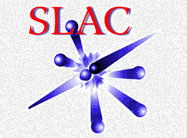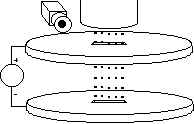 |
Search For Stable Massive Elementary Particles |  |
 |
Search For Stable Massive Elementary Particles |  |
Physics
Search for Massive, Stable, Charged
Elementary Particles
Goal:
- Search for electrically charged and stable elementary particles with masses larger than about 1013 GeV/c2.
- Such particles would have to have been created during the early history of the universe.
- Particles would have to be sufficiently abundant so that there was of order one such particle in 0.01 to 0.1 grams of some selected material.
Motivation:
- Accelerators, either under construction or projected, limit produced elementary particle masses and hence searches to below about 5´103 GeV/c2.
- Even with the requirement that the particle be stable, it is worthwhile to search for particles with masses far beyond the reach of current or projected accelerators.
Search method:
- The search method is derived from our method of searching for particles with fractional electric charged using drops falling under gravity in air. But no electric field is used.
- The essential idea is that a 1 mm radius, r, drop containing material in suspensions with an overall specific gravity of say 1.5, has a mass, m, of 1. ´10-13 kg. In elementary particle units this is about 1013 GeV/c2. The terminal velocity v is given by
v(m) = gm/(6phr), h = viscosity of air, g = acceleration of gravity
If the drop contains an elementary particle of mass M, then the terminal velocity is larger:
v(m+M) = g (m+M) /(6phr),
- Therefore by measuring the terminal velocity, v, of each of a very large number of drops of uniform radius, r, we will search for drops with an anomalously large terminal velocity v(m+M).
Remarks:
- It is necessary to measure the drop radius well, hence two methods are used:
rI is derived directly from the image of the drop and rd is derived from the Fraunhofer diffraction pattern of the drop.
- The search range is about 1013 to 1017 GeV/c2, the lower limit being set by problems in working with very small drops, the upper limit being set by the requirement that the charge of the sought particle must keep the particle anchored to ordinary matter by electrostatic force.
Reference:
- M.L. Perl, "New method for searching for massive, stable, charged elementary-particles,"
Physical Review D, v. 57(#7) pp. 4441- 4445 Apr 1, 1998.
- J. Glanz, "Superheavy Particles from the Big Bang," Science 283 1095, 1999.
[SLAC home] [MPS home] [Hist] [Phys] [FCMat] [Apparat] [TestMat] [Microdrop] [Results] [Team] [Refs]
[MPSPhys] [MSPAppat] [MPSRefs]
January 8, 2001
Stanford Linear Accelerator Center
Website maintenance: erlee@SLAC.stanford.edu